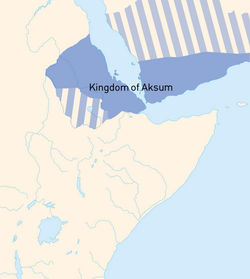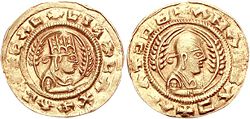
Back Koninkryk Aksoem Afrikaans መንግሥተ አክሱም Amharic مملكة أكسوم Arabic مملكة اكسوم ARZ Reinu d'Aksum AST Aksum krallığı Azerbaijani اکسوم ایمپیراتورلوغو AZB Аксум батшалығы Bashkir Aksumitisches Reich BAR Аксумскае царства Byelorussian
Kingdom of Aksum | |||||||||
|---|---|---|---|---|---|---|---|---|---|
| 1st century – 960 AD | |||||||||
Aksumite currency depicting King Endubis
| |||||||||
 The Kingdom of Aksum at its greatest extent in the 6th century | |||||||||
| Capital | |||||||||
| Common languages | (from 1st century)[3]
Various[a] | ||||||||
| Religion |
| ||||||||
| Demonym(s) | Aksumite, Ethiopian, Abyssinian | ||||||||
| Government | Monarchy | ||||||||
| Negus/Negusa Nagast | |||||||||
• c. 100 AD | Bazen of Axum (first known) Ethiopis (according to tradition) | ||||||||
• 917 or 940-960 | Dil Na'od (last) | ||||||||
| Historical era | Classical antiquity to Early Middle Ages | ||||||||
• Established | 1st century | ||||||||
| 3rd century | |||||||||
| 330 | |||||||||
• Ezana's conversion to Christianity | 325 or 328 | ||||||||
| 520 | |||||||||
| 570 | |||||||||
| 7th century | |||||||||
• Collapse | 960 AD | ||||||||
| Area | |||||||||
| 350[7] | 1,250,000 km2 (480,000 sq mi) | ||||||||
| 525 | 2,500,000 km2 (970,000 sq mi) | ||||||||
| Currency | Aksumite currency | ||||||||
| |||||||||
| Today part of | |||||||||
The Kingdom of Aksum (Ge'ez: አክሱም, romanized: ʾÄksum; Sabaean: 𐩱𐩫𐩪𐩣, ʾkšm; Ancient Greek: Ἀξωμίτης, romanized: Aksōmítēs) also known as the Kingdom of Axum, or the Aksumite Empire, was a kingdom in East Africa and South Arabia from classical antiquity to the Middle Ages. Based in what is now northern Ethiopia and Eritrea, and spanning present-day Djibouti and Sudan. Emerging from the earlier Dʿmt civilization, the kingdom was founded in 1st century.[8][9] The city of Axum served as the kingdom's capital for many centuries until it relocated to Kubar[10] in the 9th century due to declining trade connections and recurring external invasions.[11][12]
The Kingdom of Aksum was considered one of the four great powers of the 3rd century by the Persian prophet Mani, alongside Persia, Rome, and China.[13] Aksum continued to expand under the reign of Gedara (c. 200–230), who was the first king to be involved In South Arabian affairs. His reign resulted in the control of much of western Yemen, such as the Tihāmah, Najrā, Maʿafir, Ẓafār (until c. 230), and parts of Hashid territory around Hamir in the northern highlands until a joint Himyarite-Sabean alliance pushed them out. Aksum-Himyar conflicts persisted throughout the 3rd century. During the reign of Endubis (270–310), Aksum began minting coins that have been excavated as far away as Caesarea and southern India.[14]
As the kingdom became a major power on the trade route between Rome and India and gained a monopoly of Indian Ocean trade, it entered the Greco-Roman cultural sphere. Due to its ties with the Greco-Roman world, Aksum adopted Christianity as the state religion in the mid-4th century, under Ezana (320s – c. 360).[15] Following their Christianization, the Aksumites ceased construction of stelae.[11] The kingdom continued to expand throughout late antiquity, conquering Kush under Ezana in 330 for a short period of time and inheriting from it the Greek exonym "Ethiopia".[16]
Aksumite dominance in the Red Sea culminated during the reign of Kaleb of Axum (514–542), who, at the behest of the Byzantine Emperor Justin I, invaded the Himyarite Kingdom in Yemen in order to end the persecution of Christians perpetrated by the Jewish king Dhu Nuwas. With the annexation of Himyar, the Kingdom of Aksum was at its largest territorial extent, being around 2,500,000 km2. However, the territory was lost in the Aksumite–Persian wars.[17] Aksum held on to Southern Arabia from 520 until 525 when Sumyafa Ashwa was deposed by Abraha.
The kingdom's slow decline had begun by the 7th century, at which point currency ceased to be minted. The Persian (and later Muslim) presence in the Red Sea caused Aksum to suffer economically, and the population of the city of Axum shrank. Alongside environmental and internal factors, this has been suggested as the reason for its decline. Aksum's final three centuries are considered a dark age, and through uncertain circumstances, the kingdom collapsed around 960.[15] Despite its position as one of the foremost empires of late antiquity, the Kingdom of Aksum fell into obscurity as Ethiopia remained isolated throughout the Late Middle Ages.[18]
- ^ Donald Fairbairn (2021). The Global Church---The First Eight Centuries From Pentecost Through the Rise of Islam. Zondervan Academic. p. 146.
- ^ "The Periplus of the Erythraean Sea: Travel and Trade in the Indian Ocean by a Merchant of the First Century". Fordham University Internet History Sourcebooks, chapters 4 and 5.
- ^ "Snowden Lectures: Stanley Burstein, When Greek was an African Language". The Center for Hellenic Studies. 2 November 2020. Retrieved 23 February 2022.
- ^ Molefi Kete Asante (2013). The African American People A Global History. Taylor & Francis. p. 13.
- ^ Vincent Khapoya (2015). The African Experience. Routledge. p. 71.
- ^ Turchin, Peter and Jonathan M. Adams and Thomas D. Hall: "East-West Orientation of Historical Empires and Modern States", p. 222. Journal of World-Systems Research, Vol. XII, No. II, 2006
- ^ Turchin, Peter; Adams, Jonathan M.; Hall, Thomas D. (December 2006). "East-West Orientation of Historical Empires" (PDF). Journal of World-Systems Research. 12 (2): 222. ISSN 1076-156X. Archived (PDF) from the original on 7 July 2020. Retrieved 5 June 2023.
- ^ The Cultural Heritage of Aksum., UNESCO Archived 2023-10-08 at the Wayback Machine
- ^ Munro-Hay, Stuart (1991). Aksum: An African Civilisation of Late Antiquity. Edinburgh: Edinburgh University Press. p. 69. ISBN 0748601066.
- ^ Burstein, Stanley (2015), Benjamin, Craig (ed.), "Africa: states, empires, and connections", The Cambridge World History: Volume 4: A World with States, Empires and Networks 1200 BCE–900 CE, The Cambridge World History, vol. 4, Cambridge: Cambridge University Press, pp. 631–661, ISBN 978-1-139-05925-1, retrieved 19 February 2022
- ^ a b Phillipson, David W. (2012). Foundations of an African Civilisation: Aksum & the Northern Horn, 1000 BC - AD 1300. Woodbridge: James Currey. p. 48. ISBN 978-1-84701-041-4.
- ^ Butzer, Karl W. (1981). "Rise and Fall of Axum, Ethiopia: A Geo-Archaeological Interpretation". American Antiquity. 46 (3). Cambridge University Press: 471–495. doi:10.2307/280596. JSTOR 280596. S2CID 162374800.
- ^ Munro-Hay, Stuart (1991). Aksum: An African Civilisation of Late Antiquity. Edinburgh: Edinburgh University Press. p. 17. ISBN 0748601066.
- ^ Hahn, Wolfgang (2000). "Askumite Numismatics - A critical survey of recent Research". Revue Numismatique. 6 (155): 281–311. doi:10.3406/numi.2000.2289. Retrieved 9 September 2021.
- ^ a b Derat, Marie-Laure (2020). "Before the Solomonids: Crisis, Renaissance and the Emergence of the Zagwe Dynasty (Seventh–Thirteenth Centuries)". In Kelly, Samantha (ed.). A Companion to Medieval Ethiopia and Eritrea. Leiden: Brill. p. 34. ISBN 978-90-04-41958-2.
- ^ Munro-Hay, Stuart (1991). Aksum: An African Civilisation of Late Antiquity. Edinburgh: Edinburgh University Press. pp. 15–16. ISBN 0748601066.
- ^ Munro-Hay, Stuart (1991). Aksum: An African Civilisation of Late Antiquity. Edinburgh: Edinburgh University Press. p. 55. ISBN 0748601066.
- ^ Fritsch, Emmanuel; Kidane, Habtemichael (2020). "The Medieval Ethiopian Orthodox Church and Its Liturgy". In Kelly, Samantha (ed.). A Companion to Medieval Ethiopia and Eritrea. Leiden: Brill. p. 169. ISBN 978-90-04-41958-2.
Cite error: There are <ref group=lower-alpha> tags or {{efn}} templates on this page, but the references will not show without a {{reflist|group=lower-alpha}} template or {{notelist}} template (see the help page).
© MMXXIII Rich X Search. We shall prevail. All rights reserved. Rich X Search
